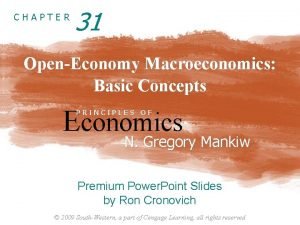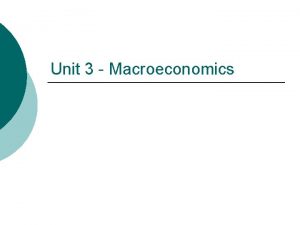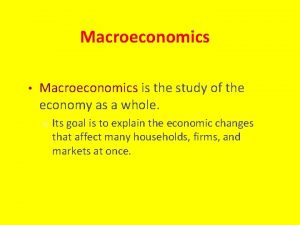Chapter 9 Introduction to Macroeconomics Macroeconomics the study













- Slides: 13

Chapter 9 Introduction to Macroeconomics

Macroeconomics • the study of the economy as a whole • We measure performance to track the development of the economy

Gross Domestic Product (GDP) • Expenditure Approach – total spent on final goods and services: – C+G+I+(X-M) where • • • C = consumption of households G = government purchases I = investment X = amount received in sale of exports M = amount spent on imports • Income Approach – add income earned by factors of production in producing the final goods and services

Gross Domestic Product (GDP) • Gross National Product (GNP) popular before mid-80’s • but it didn’t include foreign firms in Canada paying Canadian workers • Real GDP growth rate = Real GDP year 2 – Real GDP year 1 x 100 Real GDP year 1 • Real GDP per capita more informative (divide by pop. )

Drawbacks to GDP • population size (do a GDP per capita instead) • non-market production (volunteer, homemaking, etc. ) • underground economy • types of goods • leisure • environment • distribution of income

Unemployment • Unemployment rate is the percentage of the labour force not working at any given time • UE Rate = Number unemployed x 100 Labour force • Labour Force is – those employed – willing and able to work – actively seeking employment

Unemployment Issues • part-time counted as full-time • those who give up looking not part of labour force • some are overqualified • Full Employment (FE) does not mean all in labour force are working • FE may be in the 5 -7% range given the types of unemployment

Types of Unemployment • Structural – skills of workers not needed – technological replacement – replacement to other lower paying country • Frictional – between jobs (also students) • Cyclical – based on downturn in the economy • Seasonal – employment depends on climate (farming)

Okun’s Law • Okun’s Law – the GDP gap is 2% for every 1% the unemployment rate is higher than the natural rate • E. g. , Full employment is 5% • Real unemployment rate 7% • GDP gap = 4% (7 -5 x 2) • If GDP is $500 b (=96%) then potential GDP is $521 b ($500/. 96)

Inflation • Consumer Price Index – general increase in prices from one year to the next • Formula = CPI year 2 – CPI year 1 x 100 CPI year 1 • A “basket of goods” is used with weightings of different goods • A base year is used to allow comparisons • Price index • Formula = Price of Basket in current year x 100 Price of Basket in base year • Indexing – means your wage or pension is tied to the CPI

Limitation of CPI • weightings don’t reflect everybody’s spending habits • Statscan slow to change due to spending pattern changes • Cultural differences

Useful Formula to Find Unknowns: • CPI year 1 = Price, Wage, Pension in year 1 CPI year 2 Price, Wage, Pension in year 2

GDP Deflator • used to measure real GDP based on all goods and services, not just consumer goods (CPI) • Formula Real GDP = Nominal GDP x 100 GDP Deflator • the problem with the GDP Deflator was it’s use of 1992 as a base year and the changes in technology since then • Chain Fisher Volume index now used with formula to “rebase” the GDP each quarter
 Chapter 31 open economy macroeconomics
Chapter 31 open economy macroeconomics Macroeconomics chapter 7
Macroeconomics chapter 7 Macroeconomics chapter 8
Macroeconomics chapter 8 Vertical supply curve
Vertical supply curve Hát kết hợp bộ gõ cơ thể
Hát kết hợp bộ gõ cơ thể Ng-html
Ng-html Bổ thể
Bổ thể Tỉ lệ cơ thể trẻ em
Tỉ lệ cơ thể trẻ em Gấu đi như thế nào
Gấu đi như thế nào Glasgow thang điểm
Glasgow thang điểm Chúa yêu trần thế alleluia
Chúa yêu trần thế alleluia Kể tên các môn thể thao
Kể tên các môn thể thao Thế nào là hệ số cao nhất
Thế nào là hệ số cao nhất Các châu lục và đại dương trên thế giới
Các châu lục và đại dương trên thế giới

























